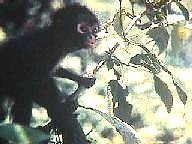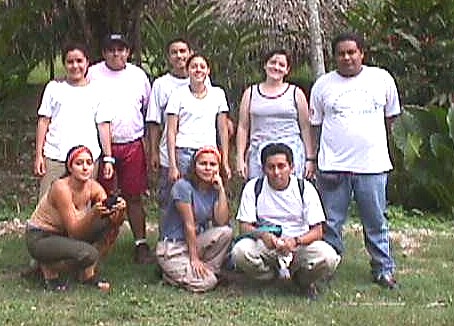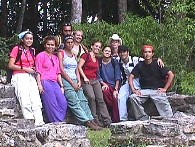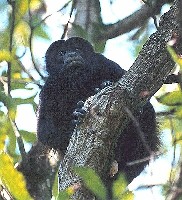

Students affiliated with the
Primate Laboratory
Estación de Biología "Los Tuxtlas"
Instituto de Biología, UNAM


|
Students affiliated with the Primate Laboratory Estación de Biología "Los Tuxtlas" Instituto de Biología, UNAM |
|
| Lucía Castellanos Velázquez,
Departamento de Biología, Facultad de Ciencias,
Universidad Nacional Autónoma de México. [email protected] Study of the population and
state of conservation status of the Black howler monkey (Alouatta
pigra) in the Mayan archaeological site of
Palenque, Chiapas. Of the two species of howler monkeys present in southern Mexico, Alouatta pigra has a restricted geographic distribution in the country and is an endemic species to the Mesoamerican region. Our knowledge of aspects of population, ecology, behavior and conservation for this species is practically non existent. This project attempts to contribute to such gap of information by gathering data on aspects of population and state of conservation of A. pigra existing within the protected area of the Mayan site of Palenque in Chiapas, Mexico. Field surveys within the Mayan site indicate the presence of about 200 howlers members of about 20 troops and some solitary individuals. Estimated population density of howlers at the site is 23 indiv/square km and mean troop size is 7.0 individuals. We are gathering information on the conservation pressures upon this important population of A. pigra. In addition we are working on developing a project to include the howler monkeys as part of the cultural attraction of the Mayan site, including disemination of the value of preserving these primates among the local human inhabitants. |

|
| Adrián Mendoza R. Departamento de Biología, Facultad de Ciencias, Universidad Nacional Autónoma de México. [email protected] Survey of the population of the Black Howler monkey (Alouatta pigra) in the fragmented ladscape surrounding the Mayan site of Palenque, Chiapas, México. The two species of howler monkeys existing in Mexico are Alouatta palliata and A. pigra. The first has a broad geographic distribution in México and in Central Amérca. However, A. pigra has a restricted geographic distribution in southern México and this primate is an endemic species to the Mesoamerican region. Our knowledge regarding aspects of population, ecology, behavior and conservation for this species is particularly poor. Such void of information is the case for populations existing in extensive areas of rain forest as well as for those existing under fragmented conditions in Mesoamerica. What kind of differences exist between populations inhabiting extensive forests and those in fragmented habitats in population parameters such as size, demographic structure, crude density, ecological density, etc., it is something that has not been documented for the species. This project, a complement to that of Lucía Castellanos (see above) with the same species in the forest of the Mayan site of Palenque, attempts to gather information on the above population parameters for the population of A. pigra inhabited forest fragments in a 10 km perimeter around the Mayan site. Preliminary surveys in some forest fragments around the site indicate the local extinction of the species and the presence of isolated troops. These are, on average, smaller than those detected at the Mayan site and displayed al altered demographic structure.We hope this study will provide information to enrich our understanding of the demographic responses of A. pigra to the fragmentation of its habitats by human activity. We hope the information will be useful to provide recommendations for the conservation of the howler monkey population existing in the landscapes surrounding the Mayan site of Palenque. |
| Emilio Barrueta Rath. Programa
Posgrado. Colegio de la Frontera Sur. Campeche, México. [email protected] Survey of the population of
the primate population and their conservation status in
Calakmul, Campeche, México. The state of Campeche forms part of the original geographic distribution of two primate species present in southern Mexico: Alouatta pigra y Ateles geoffroyi. However, our knowdledge about the size of the populations of both species and of their current geographic distribution in Campeche is scanty. Such information is urgently needed in view of the rapid and vast transformation of primate habitats to agrosystems, something which has resulted in the local extinction of both species. Our project is the first of series aimed at gathering quantititative data on the size and demographic structure of populations of A. pigra y A. geoffroyi in the Callakmul and in surrounding areas in Campeche. The project will attempt to diagnose the pressures originating from human activity related factors on remaining primate habitats by surveying primate populations in the protected forest of the Calakmul reserve and in unprotected forests in two sites in the vicinity. We will attempt to build descriptive models about the size and distribution of populations of both primate species under two different kinds of ecological scenarios and to design predictive models to produce explicit recommendations for the conservations of such populations. |
 |
| Andrómeda Rivera,
Departamento de Biología, Facultad de Ciencias,
Universidad Nacional Autónoma de México. [email protected] Effects of tropical rain
forest fragmentation on the conservation of biodiversity:
an experimental study with artificial nests in Los
Tuxtlas, Veracruz, México. The destruction, fragmentation and isolation of tropical rain forests results in the local disappearance of species and in a precarious existence for those able to survive. Forest remnants are affected by a continuous degradation caused by edge effects and by the invasion and activities of the few species that are favored by these changes. Reproductive success of individuals of forest species may be affected by these circumstances. However, information is scanty regarding this. Birds consitute the most diverse group of vertebrates in tropical rain forests and their survival is seriously afected by the transformation of tropical landscapes by man. Thus, the aim of this project, conducted in a landscape of los Tuxtlas, Veracruz, Mexico, is to determine predation patterns in artificial nests in four vegetation types: virgin forest, forest-pasture edge, vegetation corridor along a stream, and live fence formed by the planting of live posts of two tree species. Experimental design included three replicates per each vegetation type. At each site we placed on the ground along a sinuous transect, and at intervals of 50m, 10 nests with three chicken eggs each and 10 nests with three plasticine eggs each. Plasticine eggs were used to determine, by examination of markings, the general identity of the predator. Survival of both types of eggs was monitored for seven days at each site. The experiment was repeated three times in a five month period during 2000. Inicial results indicate that the lowest and slowest nest predation rates were in the virgin forest tract. Iimportant nest predators were birds, mammals and possibly reptiles. We assess aditional conservation problems suggested by such results. |

|
|
|||
| Yasminda García del Valle,
División Ciencias Biológicas, Universidad Juárez
Autónoma de Tabasco. [email protected] Use of food resources by a
free-ranging troop of howler monkeys (Alouatta
palliata) in the Yumká Park, Tabasco. The state of Tabasco in southern Mexico harbors representatives of the three species of wild primates that exist in Mexico: Alouatta palliata, A. pigra and Ateles geoffroyi. As a result of human activity a great proportion of the habitats of these three primates have disappeared or exist in a fragmented condition. Data on the natural history, ecology and behavior of these primate species is practically non existent for the state. This project attempts to contribute to this void of information by investigating the feeding ecology of a troop of A. palliata living in a 32 ha forest fragment located in the Yumká zoological park, about 15 miles from the city of Villahermosa. We hope that the information being gathered will enrich our data banks on the feeding ecology of the species in Tabasco. Such information is fundamental to understand the adaptational flexibility of members of the species to extreme conditions of habitat reduction and isolation. Such information will be useful as well in the design of conservation measures for segments of the remnant populations of Alouatta existing under similar conditions in other areas of Tabasco. |

|
| Ana
Ibarra M. División Ciencias Biológicas, Universidad
Juárez Autónoma de Tabasco. [email protected] Comparative
study of the avifauna of two traditional cocoa
plantations in La Chontalpa region in Tabasco, México.
In the state of Tabasco in southern Mexico, it has been estimated that only about 2% of the area of original tropical rain forests exists in the form of small and scattered fragments. As a consequence of this human-induced transformation, many bird species are found in areas managed for agriculture, cattle ranching, logging and urban settlements. In some Neotropical regions, traditional agroecosystems such as shaded coffee and cocoa may conserve some original components of the avian community of the forest. However, lack of sufficient studies difficult the evaluation of the value of these man-made habitats for the conservation of avian populations. The present study is a contribution in this direction and it is aimed at describing avian communities present in a typical agroecosystem in Tabasco, traditional cocoa growing. In a year-long study, 84 avian species were recorded in two 3.5 ha cocoa plantations. Twenty four percent of the species recorded were Neotropical migrants. In spite of the great similarity in the composition and structure of the vegetation between both sites, 46% of the bird species recorded were in one of the two plantations, indicating an important additive effect between plantations. Among the principal factors wich may favour the existence of the high diversity of bird species detected at the plantations investigated are the floristic richness, vertical heterogeneity of the vegetation and associated food resources. |
| David Muñoz Zetina, División
Ciencias Biológicas, Universidad Juárez Autónoma de
Tabasco. [email protected] Activity patterns of a
free-ranging troop of howler monkeys (Alouatta
palliata) in the Yumká Park, Tabasco. This project is one of a number of field studies for the first time conducted in the state of Tabasco on the ecology and behavior of howler monkeys. The state of Tabasco in southern Mexico harbors representatives of the three species of wild primates that exist in Mexico: Alouatta palliata, A. pigra and Ateles geoffroyi. As a result of human activity a great proportion of the habitats of these three primates have disappeared or exist in a fragmented condition. Data on the natural history, ecology and behavior of these primate species is practically non existent for the state. The principal aim of this project is to document the activity patterns and patterns of use of space of a troop of A. palliata existing in a small (32 ha) tract of rain forest, located on the grounds of the Yumká zoological park, 15 miles from the city of Villahermosa. We hope the information collected will contribute to the void of information on the behavior and ecology of Alouatta in Tabasco, that it will improve our understanding of the flexibility of response by howler monkeys to fragmentation and isolation of their natural habitat, and that it will provide some guidelines for the design of conservation scenarios for other isolated segments of populations of howler monkes in Tabasco. |
|
| Yenit Decena C. División Ciencias
Biológicas, Universidad Juárez Autónoma de Tabasco. [email protected] General activity patterns and
use of space in howler monkeys (Alouatta
palliata) at La Venta, Villahermosa, Tabasco. The howler monkeys of the Mesoamerican region, Alouatta palliata y A. pigra, have not espcaped the destruction and fragmentation of their natural habitat caused by human activity. This has resulted in the local extinction of the two species and in the existence of fragmented and isolated populations that are at risk. Such situation is predominant in the state of Tabasco, México. In addition, the information available on the basic ecology and behavior as well as conservation status of the two howler monkey species is practically non existent. Similarily, documentation of the responses of Alouatta to fragmentation and degradation of its natural habitat is even more sparse. Such information is indispensable, not only to build our data banks on the species of interest, but also to assess the ecological plasticity of each species. Such information may provide the tools to develop conservation scenarios to stop the continued local and regional disappearance of Alouatta. This project aims at contributing information in such direction. We are interested in documenting the general activity patterns and patterns of use of space by a troop of howlers (A. palliata) existing in a forest fragment that forms part of Parque-Museo La Venta, located in the city of Villahermosa, Tabasco. This study is a complement to that by Eugenio Fuentes (see abstract below). Both investigations will allow us to document the adaptations of howler monkeys to a habitat under extreme conditions of isolation. The study will provide important information about these primates that will be useful to promote public interest in the conservation of the the wild primates of the state of Tabasco. |
| Berenice Franco, División
Ciencias Biológicas, Universidad Juárez Autónoma de
Tabasco. [email protected]. A preliminary study of seed
dispersal by a free-ranging troop of howler monkeys (Alouatta
palliata) in La Venta, Villahermosa, Tabasco. Wild primates not only participate as primary consumers in the recycling of matter and energy in the rain forest, but also maintain other types of relationships with the plants that are their source of food and physical substratum. The dispersal of seeds by frugivorous primates is one of the most important reproductive vector for plants in tropical rain forests, as this may be the only way through which the seeds can colonize suitable microhabitats for germination and establishment. In spite of their ecological importance, the role of primates as seed dispersal agents still needs further documentation. This aim of this project is to describe the role of individuals of a troop of howler monkeys (Alouatta palliata) as dispersal agents of the seeds of trees that are their source of fruit. The study site is an 8 ha forest fragment that is part of Parque-Museo La Venta in the city of Villahermosa, Tabasco, Mexico. We expect to improve our understanding of the impact of howler monkeys on the natural process of rain forest regeneration in conditions of fragmentation and isolation of their habitat. |
|
|
| Carlos Jímenez Arano,
División Ciencias Biológicas, Universidad Juárez
Autónoma de Tabasco. [email protected] Preliminary study of activity
patterns in bats using an ultrasound detector in a
tropical landscape at Los Tuxtlas, Mexico. Members of the order Chiroptera are of particular importance in Neotropical rain forests because they constitute about 40-50% of mammal species, greatly influencing the species richness and diversity of mammals in these ecosystems. It has been suggested that bat tolerance to habitat loss and fragmentation may be related to an ability to traverse open areas to reach other forest fragments or other vegetation types and use resources within the matrix. However, documentation of use of habitats in the fragmented matrix in man-modified Neotropical landscapes is scanty and has been limited to trapping bats with mist nets and/or traps. Hence, we still lack information on the intensity of use by bats of the habitats investigated. To contribute to this void of information, we measured bat activity with an ultrasound detector in a landscape in the northeastern section of the region ofr Los Tuxtlas in southern Mexico. Bat activity was monitored in the following habitats: continuous forest, a forest fragment, a forest edge, a forest corridor, a linear strip of vegetation, a citrus grove, a pasture and in the vegetation present in a local village. We hope that the information collected will increase our understanding of bat responses to changes in the distribution of their natural habitat caused by human activity. Such information may also be useful in the design of conservation scenarios that could help preserve bat communities in the Neotropics. |
|
| Eugenio Fuentes Pech,
División Ciencias Biológicas, Universidad Juárez
Autónoma de Tabasco. [email protected] Use of food resourses by
free-ranging howler monkeys (Alouatta
palliata) at the La Venta Park,
Villahermosa, Tabasco, Mexico. The howler monkeys of the Mesoamerican region, Alouatta palliata and Alouatta pigra, have not escaped the destruction and fragmentation of their natural habitat by human activity, resulting in the local and regional extinction of both species. Such situation predominates in the state of Tabasco, where about 80% of the tropical rain forest has been converted to pastures or has given way to industrial development and oil exploration. Our knowledge of the ecology and behavior of the two howler species in this area of the Mesoamerican region is practically non existent. Similarly our data banks about the responses of Alouatta to habitat loss, fragmentation and isolation are particularly scanty. Both types of information are indispensable, no only to enrich our data banks on the natural history of the species, but also to design conservation scenarios that will avoid the continued disappearance of remnant populations. This project attempts to contribute to such void of information by studying the feeding ecology of a free-ranging troop of howler monkeys (Alouatta palliata) existing in a forest patch located on the grounds of the zoological park of La Venta in the city of Villahermosa, Tabasco, Mexico. Such extreme conditions of artificiality will allow us to document how howlers monkeys have adapted to an isolated habitat that exists in the middle of a large urban area. |

|
| Saúl Juan S. Departamento de
Biología, Facultad de Ciencias, UNAM. [email protected] Comparative study of resource
use by howler monkey groups (Alouatta palliata)
in isolated rain forest fragments at Los Tuxtlas,
México. We studied the general feeding preferences and activity patterns of howler monkey troops (A. palliata) existing in a small (3.2 ha), a medium (35 ha) and a large (250 ha) forest fragments in the region of Los Tuxtlas, Mexico. A general trend toward a more diverse resource base in the diet was evident from the small to the large forest fragments. Number of trees used ranged from 16 to 30 to 45 as forest fragment size increased. A similar trend was evident in the case of number of tree species used, raging from 6 to 15 to 22. The observed diet of the howler troop in the smallest fragment was dominated by leaf consumption and both young and mature leaves accounted for 98% of their feeding time. In contrast, in the medium and large fragments consumption of leaves accounted for 44% and 22.5% of their feeding time respectively. In addition, the diet of these troops included regular amounts of mature fruit and flowers, as has been reported for howler monkey troops existing in extensive forest tracts. The ability to use leaves as food may allow howler monkeys to face important reductions in area of their habitats and this may be the reason why howler monkey can persist, in contrast to spider monkeys, in highly fragmented landscapes, However, the ephemeral nature of the resources usually preferred by Alouatta as food (young leaves and mature fruits) indicates that such elasticity has limits. In addition, howlers may have problems of nutritional balance resulting from a diet consisting solely of leaves. |
 |
| Tana
Barrueta Rath, Posgrado Cologio de la Frontera Sur -
ECOSUR -, Chetumal, Quintana Roo, México. [email protected].Demographic survey and diet of Alouatta
pigra in a
forest fragment in Campeche.
|
| Martha
Marleny Rosales Meda, Escuela de Medicina y Farmacia,
Carrera de Biología, Universidad de San carlos,
Guatemala. [email protected]
Population survey of wild
primates in the reserve of Lanchúa, Departament of del
Petén, Guatemala..
|
 |
Thank you for your visit! |
  |
For further information about the activities of the Primate Labboratory of the Estación de Biología "Los Tuxtlas", IB-UNAM, write to: [email protected]
Copyright @ 2002 Alejandro Estrada
(Support the conservation of tropical rain forests in southern Mexico)